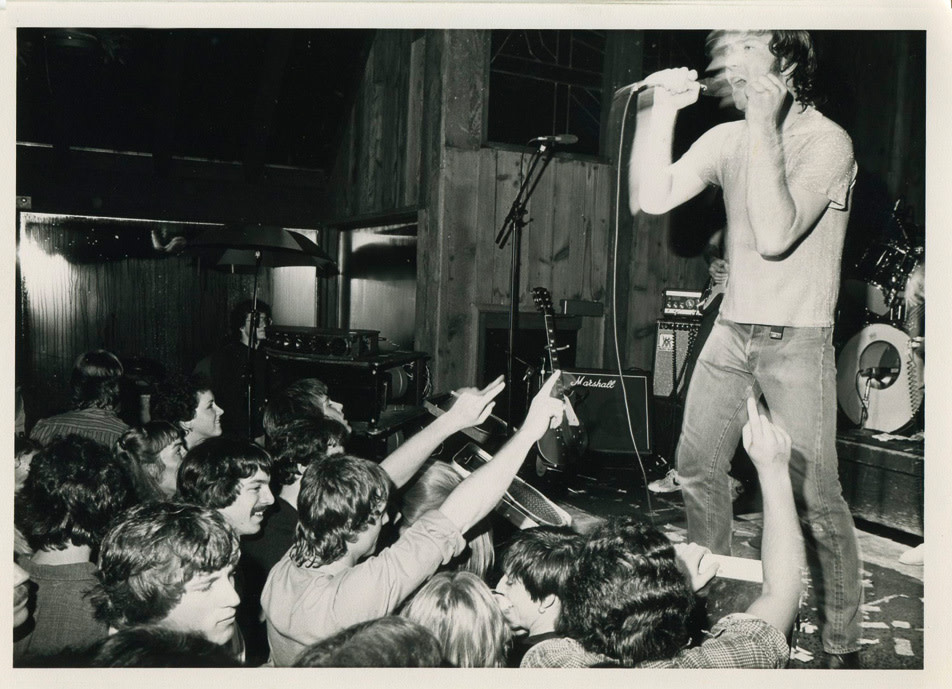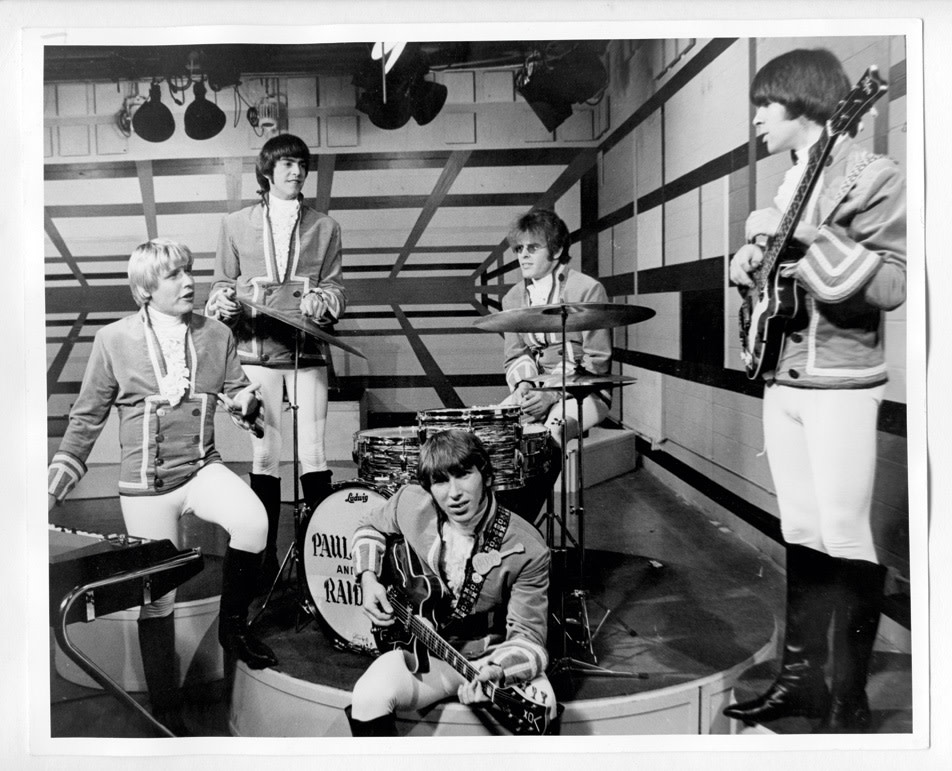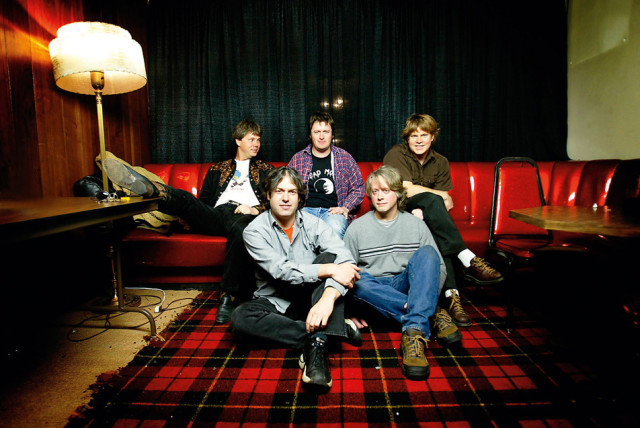Rose City Rock

Dead Moon Plays a hair-raising set at Berbati’s Pan last year.
Does Portland truly rock? No doubt. Of late, our city’s indie-rock contingent has grabbed more than its share of the spotlight, with accolades pouring in from as far away as Britain. A gushy feature about our mighty music scene that appeared in last April’s London Sunday Times called Portland “a concrete grove of bohemian dreaming.” Uh, thanks?
It’s certainly been a momentous year. The Shins and the Decemberists dropped albums that reached respectable heights on the charts and earned critical rhapsodies, while Elliott Smith’s recent posthumous song collection, New Moon , hit Billboard’s No. 24. And in late March, Modest Mouse (at least some of whom live here) released We Were Dead Before the Ship Even Sank , which debuted at (drum roll, please) No. 1. And the hits just keep coming.
So we decided “Rocktober” was an opportune month to take stock of our city’s rock heritage, singling out Portland’s greatest musical artists, past and present. After comparing notes with more than two dozen longtime music-industry locals (including Music Millennium’s Terry Currier, record-label owner Alex Steininger and Jackpot! Studio’s Larry Crane, among others), and occasionally debating whether a group truly qualified as a “Portland” band, we hammered out a roster of artists who deserve an encore. Without further ado, we present our 15 finest (in no particular order), spanning nearly 50 years of Rose City rock ’n’ roll history, all of whom left their marks on Portland—and their music ringing in our ears.
Dead Moon
1987-2006 Garage Rock
In 1965, when he was just 15, Fred Cole fronted a Las Vegas R&B group and was billed as “the White Stevie Wonder.” That was not, it turns out, mere teen braggadocio. After 43 years of playing, Cole has become a bona fide cult figure in the Northwest, thanks mainly to his recently disbanded garage-rock trio Dead Moon, which featured his wife, Toody, on bass and drummer Andrew Loomis. From Pearl Jam (which covers Dead Moon tunes in concert) to Cat Power (who recorded the band’s song “Johnny’s Got a Gun”), music luminaries revere the group not merely for its defiantly ragged sound, but also for its near-religious devotion to rock—which is as plain as the Dead Moon logo tattooed on Fred Cole’s face.
The Limelight: The documentary Unknown Passage: The Dead Moon Story , about the life and times of the venerable group, garners a host of strong reviews on the indie film festival circuit in 2005.
The Lowlight: In 1970, Fred, Toody and their kids flee to the Yukon Territory to avoid the draft, where they live in a rustic cabin and are forced to augment their diet with bear meat.
Dandy Warhols
1994-present Pop/Rock
Courtney Taylor-Taylor, the sassy front man for the Dandy Warhols, began his musical career in rather inauspicious fashion: as a doorman at Key Largo, an Old Town rock club so notorious that it was nicknamed “Large Kilo.” Small wonder, then, that when the Dandys started playing their own gigs a few years later, their live performances more closely resembled bacchanalia than rock shows: Onstage nudity was common, as were 20-minute trance jams that would whip audiences into a whirling tizzy. Such provocative theatricality earned the Dandys a deal with Capitol Records in 1996, a relationship that lasted for 10 years and four albums; although their domestic sales were modest at best, the Dandys went multiplatinum in Europe. Some bands might have taken the resulting loot and relocated to a rock megalopolis—like New York—but the Dandys? They chose to purchase a huge warehouse in Northwest Portland, their own Warholesque Factory christened the Odditorium, where they continue to pursue their orgiastic muse—and make a pretty fine living in the process.
The Limelight: The Dandys play a lead role in the 2004 art-house documentary DiG! , the story of their musical rivalry with the San Francisco-based Brian Jonestown Massacre.
The Lowlight: Capitol Records turns up its nose at the band’s first batch of recordings in 1996, citing a lack of commercial potential.

Lifesavas turn up the heat at Berbati’s pan
Lifesavas
1990-present Hip-Hop
Perhaps because they hail from a city where hip-hop doesn’t enjoy much visibility—or credibility—Lifesavas has cultivated a refreshingly anti-bling point of view. On their 2003 debut album, Spirit in Stone , Marlon “Vursatyl” Irving, Solomon “Jumbo the Garbageman” David and DJ Ryan “Rev. Shines” Shortell point and laugh at thug-life clichés while doing their utmost to maintain a positive musical vibe. “We thought we needed to come with a sound people wouldn’t necessarily expect,” Jumbo explains. “The opportunity was there for us to say something really human.” Lifesavas’ recent sophomore release, a slamming concept album called Gutterfly , provides additional evidence of the band’s more cerebral nature, drawing lyrical inspiration from the blaxploitation films of the ’70s and the groove-heavy musical cues from the same rich era. And with guest spots from George Clinton, Dead Prez and Vernon Reid, it’s clear that Lifesavas are right at home in distinguished company.
The Limelight: This year Rolling Stone magazine taps Lifesavas as one of its “10 Artists to Watch.”
The Lowlight: The group’s plans to record with legendary hip-hop producer J Dilla fail to materialize after Dilla’s untimely death from a rare blood disorder early last year.
{page break}

Johnny & the Distractions in their early 80s heyday
Johnny & the Distractions
1978-86 Rock
In his 1982 song “Complicated Now,” Johnny & the Distractions singer Jon Koonce howls, “Put on a leather jacket and scream about your broken heart,” which pretty much sums up what he’s done better than anyone else in Portland for almost three decades. His dramatic, weather-beaten voice and jeans-and-boots wardrobe earned him endless comparisons to Bruce Springsteen, as did his lyrics about fast cars, hard women and a hankering for freedom. Johnny & the Distractions put out two albums with A&M Records in the ’80s and even made the stadium rounds opening for the likes of Tom Petty, the J. Geils Band and Joan Jett. Today, the indefatigable Koonce continues to ply his trade with weekly gigs at smaller venues around town and at various McMenamins establishments.
The Limelight: The Distractions’ 1982 album, Let It Rock , sells nearly 100,000 copies, mostly in the Northwest.
The Lowlight: Their follow-up album, Totally Distracted , tanks—and then “the phone stopped ringing,” Koonce recalls.
The Decemberists
2001-present Indie Rock
The Decemberists’ Capitol Records debut, The Crane Wife , may have scaled to No. 35 on the Billboard charts late last year, but lead man Colin Meloy got his start some six years ago on the Portland open-mike circuit. Back then Meloy, a recent transplant from Montana, attempted to win over audiences at smoky bars like the LaurelThirst Pub with middling, earnest alt-country tunes—an effort that failed to impress. So he junked the country set list and tapped into his “whims and fascinations” with historical literature—and the revamped repertoire proved irresistibly offbeat. “I honestly thought I would get fewer audience members,” he recalls, “but it had the opposite effect, which is a happy accident.” Today Meloy’s morose but charming pop songs about chimney sweeps, consumptive wretches, shanghaied sailors and fallen women (who else would have two songs referencing “petticoats” on the same album?) occupy a permanent place on the playlists of indie fans everywhere, while the band’s name usually sits close to the top of the bill at major rockfests from Bonnaroo in Tennessee to nearby Sasquatch in the Gorge.
The Limelight: Decemberists guitarist Chris Funk appears on The Colbert Report late last year for a six-string showdown with the comic pundit.
The Lowlight: At the last minute, Stephen Colbert invites Peter Frampton to play in his stead. Funk loses in a controversial judges’ decision.
Poison Idea
1980-present Punk/Rock
It’s an easy jab to call Poison Idea the biggest band Portland has ever seen: Singer Jerry A weighs in at 300-plus pounds, and deceased guitarist Tom Roberts (aka Pig Champion) tipped the scales at a stout 450. But the beer-fueled and physically imposing PI was responsible for some of the most cathartic punk ever hatched: Jerry A was prone to cracking his noggin by flinging himself off the stage and could blow fire like a circus pro (a talent that resulted in bans from several local clubs). On one occasion he swallowed coins thrown at him from the crowd, and on another he carved the band’s name into his bountiful belly (the resulting carnage appears on the cover of the band’s 1986 album Kings of Punk ). That record, along with the incendiary Feel the Darkness (1990), showcases the band’s blazingly nihilistic stance and its antiauthoritarian bluster. Though album sales have never been huge, PI’s notorious legacy continues to expand.
The Limelight: Pantera covers PI’s “The Badge” on the platinum-selling soundtrack album for the Brandon Lee flick The Crow .
The Lowlight: Pig Champion dies of liver failure on January 30, 2006.
{page break}

Everclear breaks a sweat at La Luna in 1997.
Everclear
1992-present Punk/Rock
When life hands you lemons—you form a punk band. Everclear’s peroxide blond singer-songwriter Art Alexakis has bashed out a peaks-and-valleys career in rock by channeling a dismal upbringing—including an absentee father, a brother’s death by drug overdose and his girlfriend’s suicide—into wrenching rock songs like “Father of Mine” and “Heroin Girl.” Alexakis formed Everclear soon after moving to Portland in 1991 with a pregnant girlfriend in tow, and the band would log three platinum-selling albums between 1995 and 2000. Everclear’s star power has cooled since its salad days, but Alexakis remains a visible figure around town: He campaigned vigorously in Portland for John Edwards and went to the Democratic National Convention as a delegate in 2004, perhaps signaling that the angry young man has found a more purposeful outlet for his rage.
The Limelight: Everclear tops Pearl Jam and Green Day as Billboard ‘s Modern Rock Artist of the Year in 1998.
The Lowlight: Alexakis files for Chapter 11 bankruptcy in January 2005.
Quarterflash
1980-94 Pop/Rock
Before they were new-wave chart-toppers on MTV in the early ’80s, guitarist Marv Ross and his sax-playing wife, Rindy, worked the I-5 circuit in a swing and country band, playing five nights a week, sometimes five sets a night. The workload, says Ross, left him “fried,” so he borrowed $4,000 from his dad, bought an eight-track recorder and got serious about songwriting—a wise move, it turns out. A few months after its release in 1981, Quarterflash’s self-titled debut album on Geffen Records went platinum, and from 1980 to 1985, the band recorded seven songs that cracked the top 100. Between gigs by their current outfit, the Trail Band, Marv and Rindy reconvene Quarterflash about three times a year, most recently in June at Jacksonville’s Britt Festival. (They opened for Toto.)
The Limelight: On February 13, 1982, Quarterflash’s breakout single “Harden My Heart” rests at No. 3 on the Billboard charts, one notch above Journey’s “Open Arms.”
The Lowlight: Sandwiched between sets by Motörhead and the Scorpions, the band dodges batteries thrown from an unappreciative crowd at a 1983 heavy metal fest in Chicago.
The Wipers
1977-99 Punk/Rock
“Portland was the best place to be in the ’80s,” recalls Wipers bandleader Greg Sage. “It was considered a loggers’ town, overlooked by the rest of the world, but that’s why so many unique bands came out of here.” That feeling of isolation ripples through Sage’s music, and today he is still considered a patron saint of the lonely and disenfranchised—in fact, the Wipers received more votes in our informal poll than any other band. Despite Sage’s legacy of alienation, his most revered song is the 10-minute anthem “Youth of America,” a song of punk solidarity from 1981. Nearly a decade after the band’s first recordings, grunge notables such as Mudhoney, the Melvins and, most notably, Nirvana praised the Wipers as having been a huge influence. Kurt Cobain even asked Sage and his group to go on tour with Nirvana, but it never came to pass.
The Limelight: Nirvana records the Wipers’ “Return of the Rat” for the tribute album 14 Songs for Greg Sage and the Wipers in 1993.
The Lowlight: The Wipers’ 1999 comeback album, Power in One , goes largely unnoticed, revealing that angst is a dish best served by the young.
{page break}

Paul Revere & the Raiders
Paul Revere & the Raiders
1958-75 Pop/Rock
Matching suits were de rigueur in the early ’60s. So when you’re a bandleader with a name like Paul Revere, and you’re looking to develop an image, the solution is pretty obvious: colonial army uniforms and three-corner hats. So eye-catching was the Raiders’ sartorial trademark that it spawned regional imitators (the Redcoats, the Coachmen and George Washington & the Cherry Bombs, to name three). Eventually, their costume gimmickry and reputation for rowdy live shows pricked up the ears of a young Dick Clark, who in 1965 made the band regulars on his weekday teen-beat TV show, Where the Action Is. As a result, the Raiders racked up 24 charting singles, and singer Mark Lindsay enjoyed a stint as a pinup boy for 16 and Tiger Beat magazines.
The Limelight: The Raiders’ version of John D. Loudermilk’s protest tune “Indian Reservation” hits No. 1 in 1971.
The Lowlight: The band mimes and lip-syncs the novelty hit “Alley Oop”—while dressed as cavemen—on national television in 1966.
Hazel
1991-98 Punk/Rock
For anyone who was not fortunate enough to catch Hazel at La Luna or the X-Ray Café during its ’90s heyday, a “typical” show went something like this: Chatty drummer Jody Bleyle might dash across the stage chasing the drumsticks that had flown out of her hands. Bassist Brady Smith inevitably would deliver a monologue about the Baltimore Orioles, while guitarist Pete Krebs tried to maintain order and get the next song started. But most of the attention was captured by “ballerino” Fred Nemo, a bearded dervish who stood on chairs, balanced water pitchers on his head or convulsed wildly—often decked out in a flowery frock. The buzz over Hazel’s off-kilter concerts made it a must-see band, and subsequently a must-hear band: In 1993 the indie rockers became one of four local groups (Pond, the Spinanes and Sprinkler being the others) signed by Seattle’s prestigious Sub Pop Records, for whom they recorded two albums of vigorous pop-punk.
The Limelight: In 1995, Hazel’s video for “Comet” plays on MTV’s Beavis and Butt-Head .
The Lowlight: On a tour of the South in 1993, Hazel gets its entire bankroll pilfered from the van during a gig in Athens, Ga. The same night, a club owner pays the band with several cases of “green” Budweiser, causing Bleyle to be violently ill at every rest stop between Athens and Mobile.
The Kingsmen
1959-present Garage Rock
Though it’s been covered by everyone from the Kinks to Iggy Pop (there are more than 1,000 recorded versions), no one had a bigger hit with “Louie Louie” than the Kingsmen, a group of Portland teenagers who in 1963 recorded the song—for a whopping $36—at Northwest Recorders (on SW 13th Ave), the same studio where local rivals Paul Revere & the Raiders would cut the song a few days later. The Raiders ended up with a more lucrative career, but the Kingsmen hit the jackpot on this particular tune: Their take on the oft-performed Richard Berry classic was No. 2 in the nation for six weeks. “‘Louie Louie’ is the whole history of rock ’n’ roll in three minutes and 40 years,” summarizes Rolling Stone writer Dave Marsh. With a few original members (now in their 60s), the band endures to this day, still cranking out the most ubiquitous frat-rock anthem of all time.
The Limelight: In 1985, the State of Washington attempts to make the Kingsmen’s version of “Louie Louie” the state’s official song, but the campaign falls short.
The Lowlight: Lawsuits in the mid-’60s over rights to the band name between two rival factions of the Kingsmen (featuring feuding ex-members) cause confusion among fans and permanent rifts in the group.
{page break}

Elliott Smith onstage at Music Millenium NW in 1998.
Elliott Smith
1994-2003 Pop/Rock
When Gus Van Sant was asked to comment following the tragic death of his friend Elliott Smith, who contributed the Oscar-nominated song “Miss Misery” to his film Good Will Hunting , he said simply, “His songs sound like Portland.” Four years after Smith’s demise, local coffee shops are still peopled by his acolytes—somber-looking chaps filling notebooks and sporting the ever-present watch cap favored by their fallen hero. Smith’s darkly whispered tunes such as “Rose Parade” and “Alameda,” about life on the margins of Portland, not only provided a stark counterpoint to the last gasp of grunge, but also helped lay the groundwork for a host of confessional singer-songwriters (a term that Smith, in fact, detested). Whether recurring depression and/or drug use led to his suicide by knife to the heart in 2003 remains a question mark (the case is unresolved), but there’s no debating the abiding influence of his work on our gritty little city.
The limelight: A rather shaky Smith sings "Miss Misery" at the 1997 Academy Awards. He’s beaten out by Celine Dion’s glutinous "My Heart Will Go On" from Titanic, but his star is officially at its apex.
The lowlight: Smith’s two-year lapse into heroin addiction after the release of his Figure 8 album in 2000 includes a dust-up with the cops at a Flaming Lips show in 2002.

Richmond Fontaine backstage at Doug Fir Lounge in 2004
Richmond Fontaine
1985-present Country Rock
The British have had a long, well-documented fascination with the savagery of the American West, which is about as good an explanation as any for why Richmond Fontaine’s epic, gritty music has generated such a rabid following across the pond—after nearly 10 years of slogging away at home. The band’s conversion from hardworking alt-country boys to Continental critical darlings came about thanks to a barrage of high praise from English magazines like Mojo and Uncut , the latter of which practically adopted the group and dubbed lead singer and songwriter Willy Vlautin “the laureate of the lost, the lonely and the rootless.” All the attention has enabled Vlautin to embark on a promising second career as a novelist—his debut, The Motel Life , was an Editors’ Choice of the New York Times Book Review this summer.
The limelight: In 2004, Uncut magazine names RF’s album Post to Wire the fourth-best album of the ear, behind releases from Brian Wilson, Wilco and Loretta Lynn.
The Lowlight: A bad review in a 1997 issue pf indie-rock magazine Magnet nearly convinces Vlautin to abandon music and return to school.

Sleater-Kinney
Sleater-Kinney
1994-2006 Punk/Indie Rock
Despite Sleater-Kinney’s identification with the Olympia, Wash., rock scene (they’re named after a nearby freeway off-ramp and recorded for an Olympia label), Corin Tucker, Carrie Brownstein and Janet Weiss have called Portland home for several years and played enough local shows to warrant inclusion in this company. Residence quibbles aside, the trio’s chops, creative drive and incalculable empowering influence on their fan base have made them one of the most talked-about and critically lauded indie groups of the last decade. From their brash and ragged early days as riot-grrrl champions to their highly polished and bombastic final album, The Woods , Sleater-Kinney never stopped pushing forward creatively, in the end even choosing to go on “indefinite hiatus” last year rather than risking a rehash of musical ideas. And despite overtures from major labels, Sleater-Kinney chose freedom and control over lucre, remaining with the fiercely independent labels Chainsaw and Kill Rock Stars until moving to Seattle’s Sub Pop to record its last album in 2005.
The Limelight: In 2001 Time magazine calls Sleater-Kinney “America’s best rock band.”
The Lowlight: Sleater-Kinney reaches a sufficient level of success to inspire a local backlash: Portland band the Punk Group releases its cheeky anthem, “Sleater-Kinney Sucks,” in 2004.




